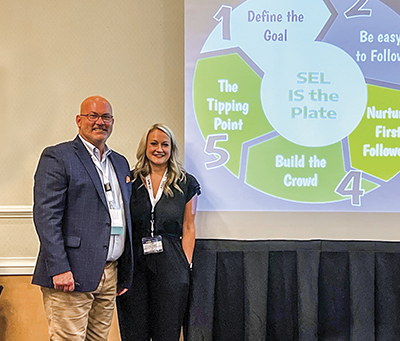Naperville’s Essential Integration of SEL
November 01, 2022
LIGHTHOUSE SYSTEMS
(3rd in a series)
Running high-performing, high-achieving schools in a community with concomitant expectations for its children can be a mixed blessing.

Consider the experiences of school system leadership of the Naperville Community Unit School District 203, with its 16,500 students attending 23 schools, located about 30 miles west of Chicago.
“With the expectations to do well in school and pressure to succeed, where can students find support?” says Dan Bridges, superintendent since 2011. To achieve what he labels “a systemic transformation of schools moving forward,” the district focuses on making social emotional learning the foundation of its approach, which has earned the district its status as an AASA Lighthouse district, one of 12 nationwide.
Naperville made sure SEL was not going to be yet another add-on for its teachers. As Lisa Xagas, assistant superintendent for student services, says, “SEL is the plate. … SEL holds everything up.”
Grade-Level Rubrics
For the past nine years, there has been a focused effort on “community engagement and being challenged to work on supporting students’ mental health,” Bridges says. “There’s community-wide awareness of the amount of pressure on students.”
Several suicides in the community involving students and family members underscored the importance of working on individual resilience. He adds, “It’s giving tools to build strengths. We wanted to celebrate what [students] do well and build resilience.”
How does that translate in the classroom and culture?
The district developed clear rubrics, with specific goals and expectations, for each grade, that measure how SEL should be applied to content areas and student behavior. Recognizing parents’ discomfort and uncertainty about SEL, the district increased its outreach and communication about how SEL worked at each grade level through SEL Snapshots.
These were graphic explanations about the skills students should demonstrate at different ages, as well as potential problems that parents should identify.
Bridges and his team developed a rubric for SEL, beginning with his notion that “students have to be well and have confidence to be able to learn. In an inclusive school community, there’s a system of supports academically and behaviorally. … It’s a continuous improvement model.”
In elementary school, 3rd graders learning multiplication tables start with two-digit numbers and progress. Part of the SEL curriculum, explains Xagas, is “how I can persevere when I hit an obstacle. I can find and know my opportunities. I can collaborate as the work gets more progressive in complexity.”
Middle school students studying a text can identify characteristics about supporting characters in a piece of literature, for example, and “understand the perspective of people who don’t know about things outside our world,” she adds.
By the time students are in high school, a social studies lesson about current events and genocide would engage SEL by asking students to consider “responsible decision making” in this context, Xagas says.
“SEL is being aware of yourself and others, how you show up based on lived experience and identities,” she adds.
Other strategies include an awareness of how a student might choose her or his emotions through techniques such as reframing second chances in moments of personal frustration.
Countering a culture of perfection in a well-to-do community such as Naperville means teaching people it’s acceptable to fail and to try again. “It’s recognizing when students are struggling and focusing on strengths, [that] not everyone has to be perfect in everything,” Xagas says.
“When you’re in a high-performing culture with high expectations that you have to be perfect,” Bridges says, individuals must “learn how will you bounce back … It’s ok to take risks.” He uses the metaphor of a trapeze. “It’s scary, but there’s a safety net.”
Staff Support, Too
SEL also applies to teachers and staff in Naperville.
“We have worked hard to create a culture where staff should feel comfortable in asking for help,” the superintendent says. Before launching the SEL curriculum for students, the district provided two years of training for teachers, though Bridges admits he had underestimated teacher need for “explicit instruction on SEL and adult competencies.”
For the initiative to fully succeed, parents must ensure they are providing supports at home.
Some initial measurements have been encouraging. In 2017-18, chronic absenteeism was close to 10 percent. In 2018-19, it had fallen to 4.5 percent. In Year 1, mental health hospitalizations for students fell 7 percent. By Year 2, mental health hospitalizations had fallen by 23 percent.
“Degrees might get you a job, but social skills are what let you keep it,” Xagas says.
Author
Advertisement
Advertisement
Advertisement
Advertisement


.png?sfvrsn=3d584f2d_3)
